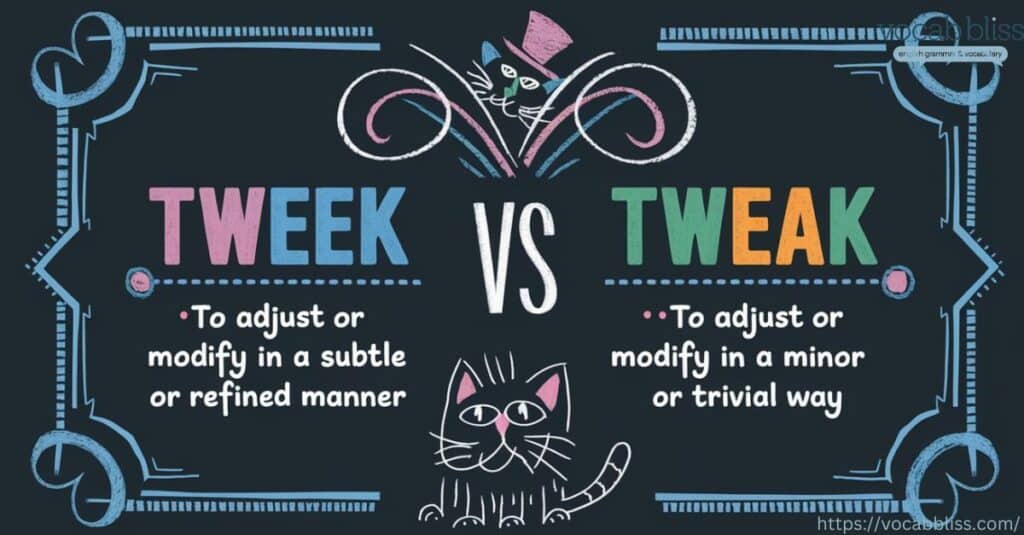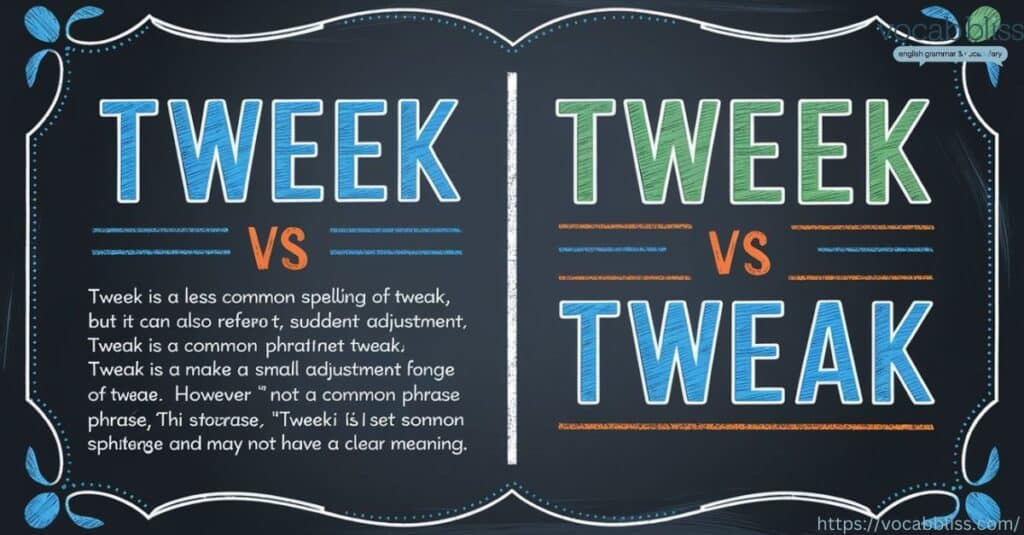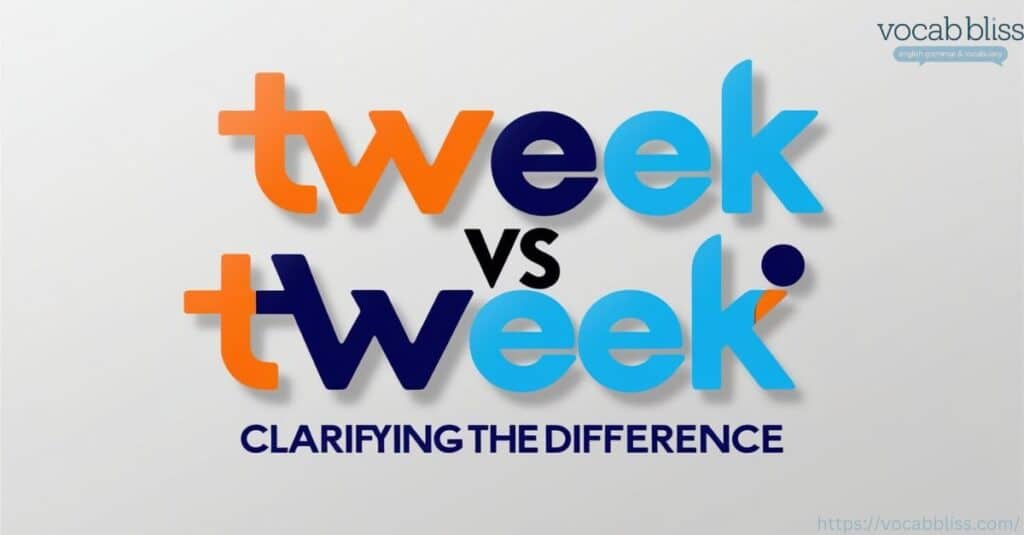Confused about whether to use tweek vs tweak? You’re not alone. This pair of similar-sounding words often trips up even the most careful writers. But in writing, clarity and accuracy matter a lot.
Whether you’re talking about adjustments in software, modifications to a recipe, or fine-tuning a marketing strategy, getting the spelling right is essential. So, let’s dive into the distinctions between “tweak vs tweek,” explore the definition, usage, and common misspellings of each term, and discover why accuracy in word choice is a must.
Teasing can be a fun way to add humor, but it’s important to know your audience. If you share a close relationship, a gentle tease can bring a chuckle. Try something like, “Another year older, but not necessarily wiser! Happy Birthday Wishes in Marathi !” Always ensure your teasing remains friendly and doesn’t cross the line. You want to make them smile, not cringe
What Is “Tweek”?
Is Tweek a Word?
First things first: is “tweek” even a word? Short answer: not really. While “tweek” sometimes pops up in casual online conversations, it isn’t an accepted spelling in formal writing or any standard dictionary. In the English language, “tweek” is considered a misspelling of the actual word “tweak.”
Why Do People Use Tweek?
The mistaken use of “tweek” likely stems from:
- Phonetic confusion: Since “tweek” and “tweak” sound nearly identical, some people assume they are interchangeable.
- Typing errors: In fast-paced typing environments, the difference between “tweak” and “tweek” can come down to a quick typo.
- Informal contexts: Online slang and chat platforms sometimes favor creative spellings like “tweek,” especially among younger users.
Tweek in Dictionary Definitions (or Lack Thereof)
A quick search in any reputable English dictionary will confirm that “tweek” does not exist as a standard word. While it appears in internet slang or in certain casual contexts, it’s not recognized as a formal or professional term. The actual word is “tweak,” which we’ll explore in detail.
Key Takeaway: If you’re aiming for clarity, stick with “tweak.” Using “tweek” could make your writing look unpolished or unprofessional.
Misconceptions and Usage Errors
“Tweek” often shows up in:
- Social media posts where informal language is common.
- Casual conversations that prioritize quick communication over accuracy.
- Technical discussions, where users might inadvertently use “tweek” while talking about fine-tuning software code or minor adjustments in settings.
For professional purposes or in formal writing contexts, it’s best to avoid “tweek.” Now, let’s move on to the real star of the show: tweak.
Understanding “Tweak”
Is “Tweak” a Correct Word?

Yes! Tweak is the accepted, standard spelling in English and is widely used across various contexts, from technology to design to communication. In the dictionary, “tweak” is defined as a small adjustment or minor change made to improve something, whether it’s software functionality, a marketing strategy, or even presentation slides.
Definition of “Tweak”
According to most dictionaries, “tweak” means:
- To make a minor adjustment or modification to something, especially to improve its efficiency or appearance.
- To pinch or pull lightly, often in a playful manner.
The primary usage, however, involves improvements and fine-tuning to achieve a better result. For example, you might tweak a color scheme to make it more appealing or adjust software code to fix a bug.
Contextual Meaning and Nuance
“Tweak” implies a small, precise change, usually one that doesn’t fundamentally alter the original structure but instead enhances it. Here’s where you might encounter “tweak” in different contexts:
- Professional writing: Refine sentences or clarify points for better communication.
- Marketing strategy: Small adjustments to messaging or targeting for improved results.
- User experience: Fine-tuning the design to enhance user interaction.
- Recipe adjustments: A pinch of salt here, a dash of spice there—small tweaks to taste.
Quote: “In professional contexts, a tweak often means making an existing setup just a bit better, without a complete overhaul.”

Tweek or Tweak: Which One Is Correct?
When deciding between tweak or tweek remember that tweak is the only correct choice in standard English. Here’s why:
- Accepted in dictionaries: Tweak has definitions in all reputable English dictionaries, while “tweek” does not.
- Professional appearance: Using “tweak” conveys accuracy and attention to detail.
- Standard spelling in all English variants: Whether in the US or the UK, “tweak” is universally accepted.
When to Use “Tweek vs Tweak”?

The choice between “tweek” and “tweak” boils down to context and formality. In casual contexts, such as personal text messages or social media posts, “tweek” might be understood, though it’s not correct. However, in any setting where accuracy, clarity, or professionalism matters—such as in business, academic papers, or professional emails—“tweak” is the proper choice.
“is it Tweek or Tweak” in US and UK English
In both US and UK English, “tweak” is the correct and accepted spelling. Unlike other words with regional variations (like color vs colour), “tweak” remains consistent in spelling and meaning across different English-speaking countries.
Side-by-Side Comparison: Tweek and Tweak
Here’s a quick comparison to clarify the differences:
| Aspect | Tweek | Tweak |
|---|---|---|
| Definition | Not a standard English word; misspelling | Small adjustments, fine-tuning, minor improvements |
| Usage | Informal, online slang | Accepted in formal and informal contexts |
| Common Contexts | Casual chat, social media, informal posts | Professional writing, design, user experience |
| Dictionary Validity | Not listed in dictionaries | Listed in all major dictionaries |
| Examples | “I need to tweek my setup” (incorrect) | “I’ll tweak my setup for better performance” (correct) |
Everyday Usage Examples of “Tweak”
Let’s look at how “tweak” fits naturally into various sentences:
- In software: “The developer made a few tweaks to the code to improve speed.”
- In design: “They tweaked the color scheme to make it look more modern.”
- In everyday conversation: “I’ll just tweak the recipe by adding a bit more garlic.”
Examples of Incorrect Use (Tweek)
Here are some common misspellings using “tweek” instead of “tweak”:
- Incorrect: “I’ll make a few tweeks to the report.”
- Incorrect: “Can you tweek the layout for me?”
Pro Tip: When in doubt, double-check for spelling accuracy in professional contexts. Small details like these add up!

Why People Mis “spell Tweak” as Tweek
Common Reasons for Confusion
The frequent misspelling of “tweak” as “tweek” can be attributed to:
- Phonetic similarity: The words sound alike, making the mistake easy to overlook.
- Casual typing errors: Especially common in quick, informal writing.
- Autocorrect issues: In some text editors or devices, “tweek” may slip through if not flagged.
Other Common Misspellings of Tweak
Some additional misspellings include:
- “Tweaque” – an exaggerated misspelling.
- “Tweck” – sometimes appearing as a typo.
These errors, though less frequent, serve as reminders of why spell-checking is essential, especially in professional settings.
Synonyms for “Tweak”
For variety in your writing, consider these synonyms that offer similar meanings to “tweak”:
- Adjust: Ideal for describing minor changes.
- Modify: A more formal alternative often used in technical contexts.
- Refine: Conveys subtle improvement, especially in design or writing.
- Edit: Common in writing contexts.
- Fine-tune: Often used in technical fields, like engineering or software.
Note: Although these words carry similar meanings, they may not be direct substitutes depending on context. Use “tweak” when referring specifically to small improvements or minor adjustments.
Tweeks or Tweaks: Which Is Correct?

The words “tweeks” and “tweaks” may look similar, but only one is correct in standard English. “Tweaks” is the accurate spelling, while “tweeks” is a common misspelling. The term “tweak” means to make a small adjustment or fine-tune something, often for improvement.
You might use it when editing a document, adjusting software settings, or modifying designs to enhance their functionality. However, “tweeks” has no official recognition in English dictionaries and is viewed as an error.
Let’s look at a few examples to clarify the usage:
| Incorrect (Tweeks) | Correct (Tweaks) |
|---|---|
| “I need to make some tweeks to the website.” | “I need to make some tweaks to the website.” |
| “Can you tweek the color scheme a bit?” | “Can you tweak the color scheme a bit?” |
| “The app has a few tweeks for better speed.” | “The app has a few tweaks for better speed.” |
In each example, substituting “tweeks” for “tweaks” immediately corrects the spelling and improves the professionalism of the sentence. Using the correct form, “tweaks,” shows that you’re mindful of spelling accuracy—a small detail that can make a big difference in formal communication. So, remember, whether you’re tweaking code, recipes, or design elements, always go with “tweaks” for polished, effective writing.
Conclusion
When it comes to “tweek” vs. “tweak,” clarity and correctness are crucial. Tweak is the standard, dictionary-recognized spelling, and it’s best suited for any formal or professional setting. On the other hand, “tweek” remains a common misspelling with no formal standing in English dictionaries.
Whether you’re discussing small adjustments to software code, fine-tuning a marketing strategy, or making minor recipe changes, tweak is the word that fits seamlessly into both
Remember, spelling matters, and using “tweak” over “tweek” can help ensure your communication is polished, accurate, and effective. So, next time you’re about to make a small change, go ahead and tweak it—confidently and correctly.
Dive Deeper:
- Simpler or More Simple? How Do They Differ?
- Arial or Aerial? Sorting Out the Differences
- Happened or Happend: Is It This or That?
- Exception vs Exemption: What Sets Them Apart?
- Preform Vs Perform: What’s The Difference?







